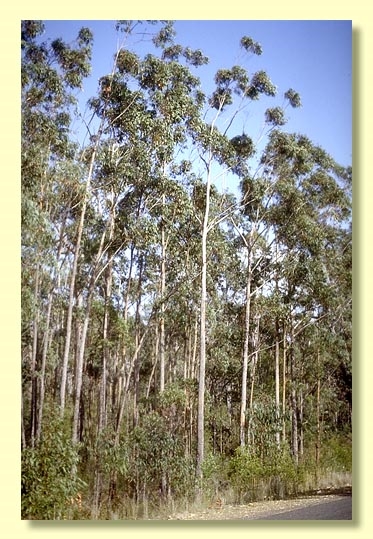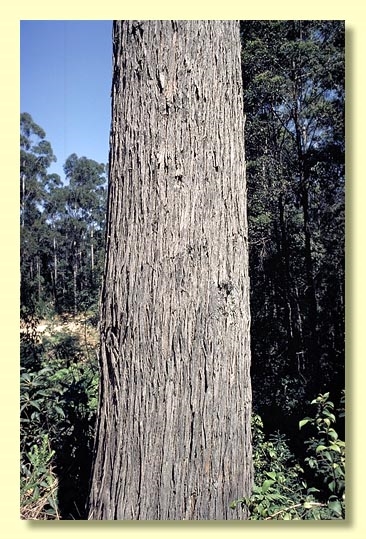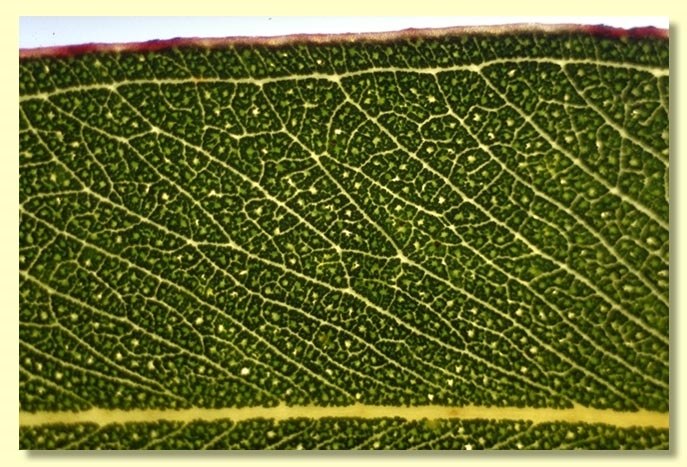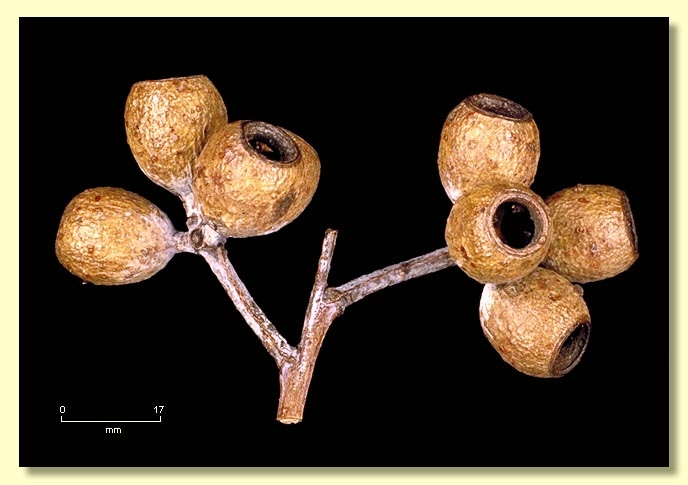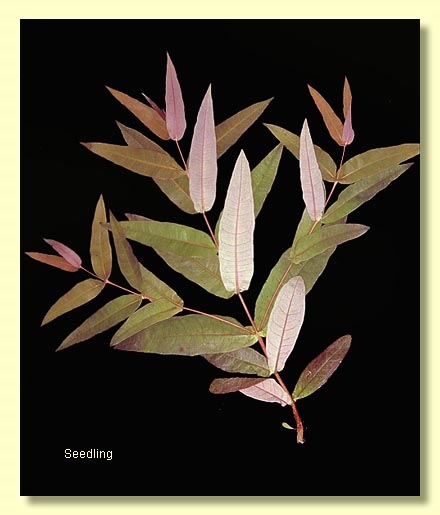Euclid - Online edition
Eucalyptus pyrocarpa
Eucalyptus | Eucalyptus | Pseudophloius
Eucalyptus pilularis var. pyriformis Maiden, J. & Proc. Roy. Soc. New South Wales 47: 94 (1913).
T: Bucca Ck near Coffs Harbour, NSW, June 1911, J.L.Boorman 3; lecto: NSW, fide L.A.S.Johnson & D.F.Blaxell, loc. cit.; isolecto: BM, CANB, K, MEL; several syntypes, same locality, date and collector; NSW.
Bark rough to larger limbs, fibrous, grey or brown; smooth bark grey to white, crown sometimes ribbony; branchlets glaucous and square in cross-section.
Juvenile growth (coppice or field seedlings to 50 cm): stem square in cross-section, glaucous; juvenile leaves opposite and sessile until early sapling stage, lanceolate, 12.5–23 cm long, 1.6–2.5 cm wide, discolorous, green.
Adult leaves alternate, petiole 1–2.4 cm long; blade lanceolate to falcate, 9–24 cm long, 1.5–4 cm wide, base oblique to tapering to petiole, concolorous, glossy or dull, green, side-veins at an acute or wider angle to midrib, moderately to densely reticulate, intramarginal vein parallel to and well removed from margin, oil glands mostly island.
Inflorescence axillary unbranched, peduncle broadly flattened, 1–2.5 cm long, buds 7, 9 or 11 per umbel, on pedicels 0.2–0.7 cm long. Mature buds obovoid to fusiform to pyriform or diamond-shaped, 0.9–1.3 cm long, 0.6–0.7 cm wide, green to yellow and slightly glaucous, sometimes faintly ribbed longitudinally, scar absent, operculum conical to beaked, stamens irregularly flexed, anthers reniform to cordate, versatile, dorsifixed, dehiscing by confluent slits, style long, stigma blunt or tapered, locules 4, the placentae each with 2 vertical ovule rows. Flowers white.
Fruit sessile or with pedicels to 0.6 cm long, cupular, barrel-shaped or pyriform, 1–1.5 cm long, 0.9–1.7 cm wide, glaucous or non-glaucous, disc raised-convex to annular, level or descending, valves 4, near rim level or enclosed.
Seeds brown, 2–4 mm long, pyramidal or obliquely pyramidal, dorsal surface smooth or shallowly pitted, hilum terminal.
Cultivated seedlings (measured at ca node 10): cotyledons reniform; stems square in cross-section and winged, glaucous; leaves sessile and opposite for many nodes, lanceolate, 10–13 cm long, 2–3.5 cm wide, amplexicaul, margin entire, apex pointed, discolorous, dull, green to grey-green above, paler beneath.
Flowering has been recorded in February, March and August.
A medium-sized forest tree occurring in coastal and subcoastal New South Wales from Wauchope in the south, north to Woodburn. Eucalyptus pyrocarpa has rough bark on the trunk and larger limbs, smooth bark on the branches, green adult leaves and has glaucous branchlets, buds and fruit. It forms a mosaic distribution with the other closely related blackbutt species, E. pilularis, which differs in preferring more fertile sites, has more spherical fruit and is not glaucous in the buds and fruit as is E. pyrocarpa.
In the classification of Brooker (2000) Eucalyptus pyrocarpa is in Eucalyptus subgenus Eucalyptus section Pseudophloius (the pseudo-stringybarks), because the rough bark is fibrous, inflorescences are axillary, buds have a single operculum, anthers are reniform, ovules in two rows on each placenta, seeds more or less pyramidal, and juvenile leaves are sessile and opposite for many pairs on stems conspicuously square in cross-section. There are two species in section Pseudophloius, E. pilularis and E. pyrocarpa .

